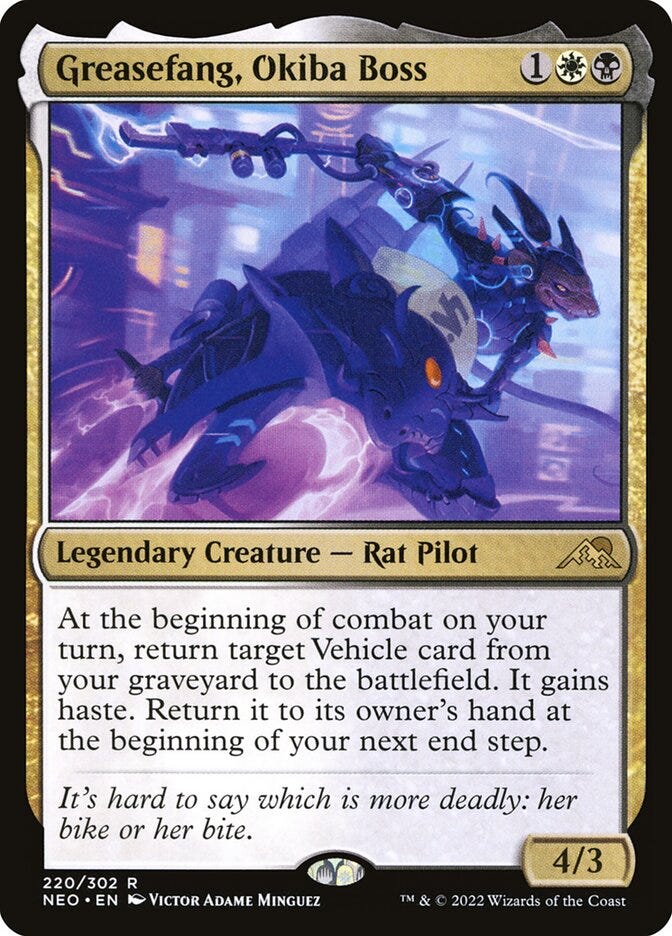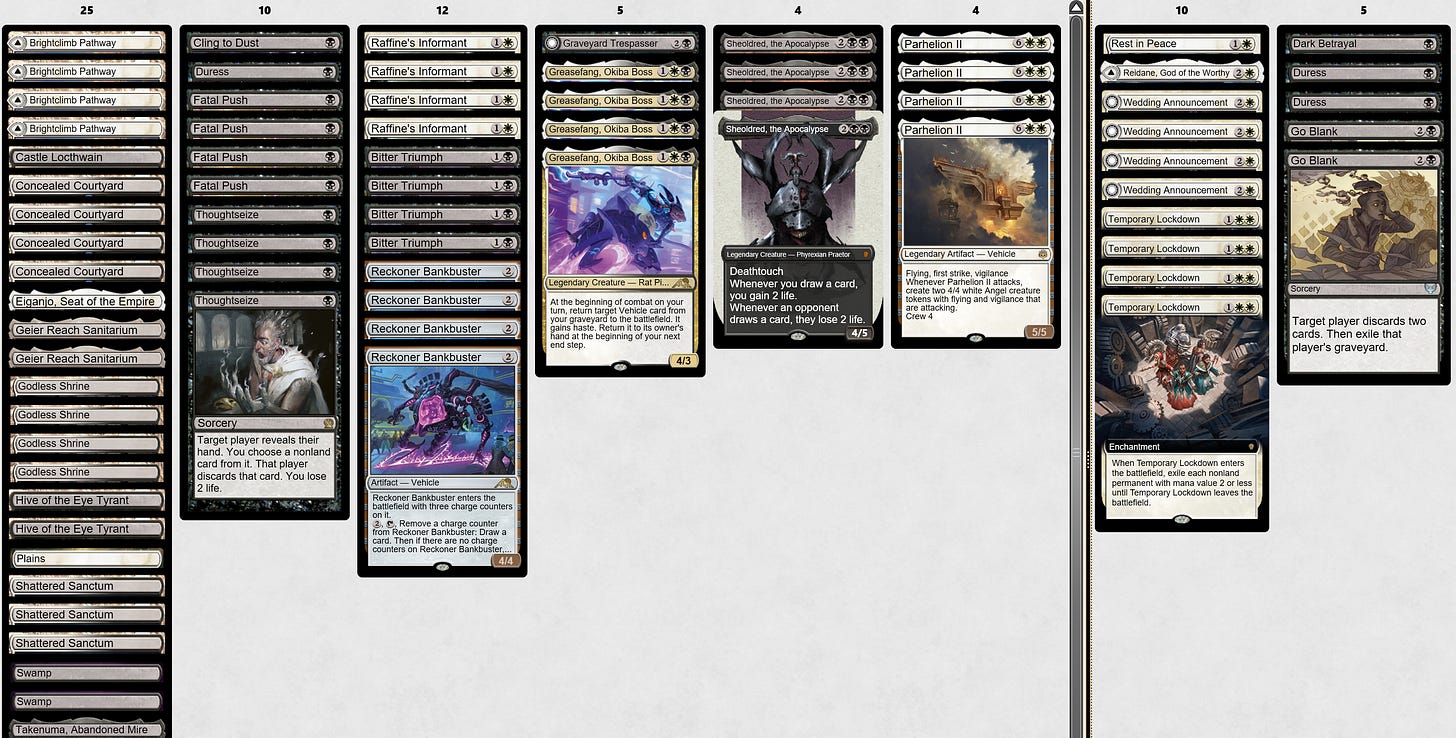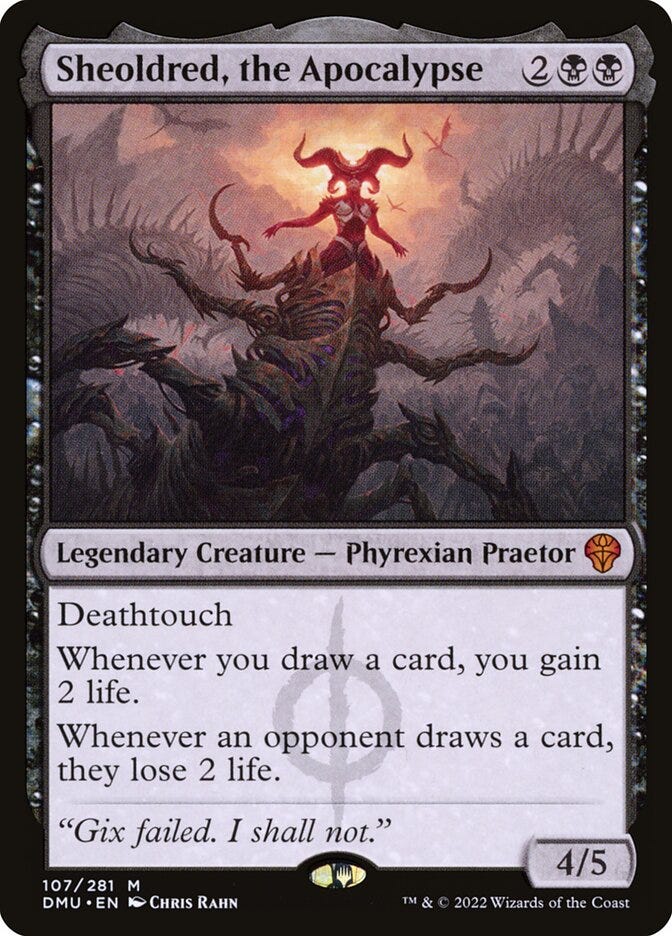I have been working on an Orzhov Greasefang list. I got three 4-1’s in a row with it out of the gate, so decided to take it through some higher level events.
I played in the Super Qualifier on 12/23 and went 6-3, but had the best breakers and was a hairs breath from Top 8, missing back to back win and ins with the winning Greasefang being one card away. I then played in the 12/29 challenge where I went 7-0 in the main and lost the first round of top 8.
So overall I am at an 80% winrate with this deck over a reasonable sample including some high level events. That is far better than Greasefang did at the recent RC where it was a 40% winrate. So what am I doing different?
Optimizing for post-board games
Greasefang is a classic example of a deck that has a strong game 1 matchup, but gets substantially worse post-board as people can bring in targeted high impact hate (graveyard hate and one mana instant speed removal for Greasefang like Rending Volley).
I decided to build a deck that flips that equation, where I have a so-so game 1, but a strong post-board winrate. Why is that difference so impactful?
(Source NBA.com)
Above is a striking chart about the increase in 3’s taken in the NBA. There is very simple math powering this trend, 3 points are substantially more than 2 points.
In Magic we have a similar equation where 2 post-board games is substantially more than the 1 pre-board game, so similar to the higher return of shooting a 3 in the NBA, there can be high returns to prioritizing your post-board games.
Which would you pick a deck with a flat 60% winrate each game, a deck with a 80% game 1 winrate and 50% post-board, or a deck with a 20% game 1 winrate and 80% post-board? Their expected match winrates are 65%, 65%, 70% respectively, which tells the story of the importance of post-board
I suspect many brewers think of a maindeck idea and then come up with a sideboard if the maindeck idea is good. I try to think of the main and various post-board permutations together and gravitate towards decks that I think have a particularly interesting post-board gameplans and I believe this is a particular strength of mine as a brewer.
How did I do that with Greasefang
Here is the list I played in the Super Qualifier
And here is the later list I played in the Challenge
The key thing is these are not Greasefang decks, I mean I run Rest in Peace in the board. They are more Sheoldred decks than anything else. So why the Greasefang at all, especially in the second list where there are hardly any vehicles?
I am playing Greasefang to get my opponent to sideboard wrong. When I side out the Greasefang (and Parhelion in the first version) in any interactive matches, think about what the post-board games look like. My opponents are bringing in cards like Rest in Peace and Leyline of the Void (dead), Unlicensed Hearse (weak), and cards like Ray of Enfeeblement and Rending Volley that can now only hit Informant (so also weak).
By playing Greasefang in the main and my opponents reacting to it in their sideboard decisions it is effectively like my opponents are starting both post-board games on a mulligan. Your winrate goes way up when your opponent mulligans, so this is massively increasing my winrate in post-board games.
I get further advantage when Greasefang gets them to play wrong. The perceived threat of Greasefang causes them to hold up removal for Greasefang, creating tempo for me. They also mis-assess threats and are quick to fire off removal on Greasefang that should be saved for Sheoldred. There are very few threats, especially at less than four mana, that can make an opponent worry more about it than Sheoldred. Greasefang is one of the only ones and I am taking full advantage of that here.
This all works at the moment because the cost of convincing my opponents I am Greasefang deck is not that high in the current meta. Midrange decks need card selection, so I already play Raffine’s Informant as a two drop in Orzhov Midrange decks.
Bitter Triumph is currently a particularly well positioned removal spell with the popularity of control making you want more planeswalker removal. I maybe would not be playing 4 in a vacuum, but the marginal cost of running one over the alternative of a Go for the Throat is low relative to the impact of helping convince I am a Greasefang deck.
Reckoner Bankbuster is a vehicle, which has legitimate synergy with Greasefang and helps convince the opponent that I am a Greasefang deck. But I am playing it primarily because any Orzhov midrange deck I play would be playing it. I have discussed before how powerful Bankbuster is and with how the format has slowed down since the bannings, it is not out of the question that Bankbuster is the best card in the format at the moment.
Then Greasefang itself is still a 4/3 for three. Nothing great, but definitely not a zero, especially when you combine with the occasional potential to bring back a vehicle for free.
The Parhelion II’s were the one card that was huge opportunity cost. I would occasionally combo with them, but they were dead too often, so I decided to cut them from the deck entirely, figuring Greasefang, a few vehicles, and the discard outlets would be enough to convince my opponent I was a Greasefang deck.
The first list you can consider as a transformational sideboard with the Parhelion’s and Greasefang coming out most games. The second list, I would not even call a transformational sideboard. It is even stronger than that because the maindeck is basically just an Orzhov midrange list. But the key is my opponents are perceiving the deck to be something it is not. So I gain the advantages of a transformational sideboard with only incurring a fraction of the costs that a transformational sideboard has in limited sideboard slots.
Sideboarding as a brewer’s source of advantage
Sideboarding is possibly the biggest source of advantage we have as brewers. When I face someone, they are facing my deck for the first time and as they sideboard are trying to figure out what’s going on and come up with a plan. On top of that, none of the cards in their board were put their with this particular matchup in mind. In contrast, I have likely faced their deck multiple times and have cards in my board specifically targeted at the matchup along with practiced gameplans.
Even better, the opponent is going to be sideboarding against what they just saw. This leads to them overreacting and going with seemingly “obvious” choices (i.e. “Greasefang cares about the graveyard, I should bring in graveyard hate”). This creates huge opportunities to anticipate their adjustments and adjust your plan accordingly. This means they’re boarding for your game 1 deck, while you are a step ahead boarding for their post-board deck.
The extension of this is there is a huge advantage for Brewers to increase the difference between their game 1 deck and their post-board deck. This Orzhov “Greasefang” list is an extreme and very clear example of this, but it is something I am always thinking about with my brews.









I have been thinking about this very thing! There is such a low cost to running a "Greasefang package". In Yugioh, decks can use lots of different "engines" consisting of groups of cards (3 or more cards per engine). These engines can be synergistic with the rest of the deck but can also contain a 1 or 2 card combo that does something big. The idea being how splashable and low the relative cost is to playing the engine and how it doesnt interrupt what your A plot os trying to do. You basically just have to have room in the deck to run the engine.
Same thing applies here. Usually things in pioneer aren't as precise as they are in yugioh where they have free searches. Usually you just run cards that are synergistic (play ramp cards and cards that cost a lot for example). But in Greasefang, you basically only need like... 9 or so cards to play it. The rest is up for grabs.
I had a great time 2 weeks ago playing one of these lists and watching in game 2 my opponent play necromentia against me when I actually sided out all of the greasefangs lol. The only match I lost was against Lotus Field combo.
Nice one! Would love to see some golgari midrange brew ideas or tips!